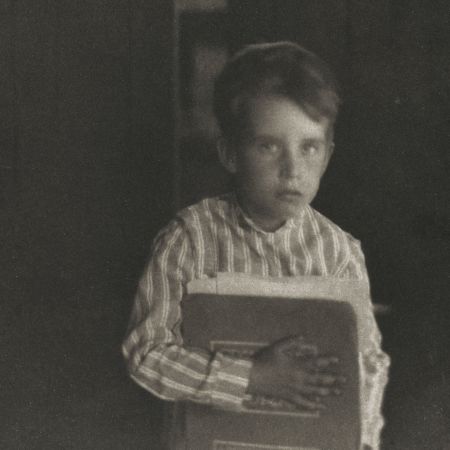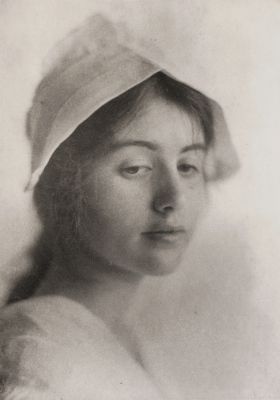
Title
Whitefriar MonksArtist
Annan, James Craig (Scottish, 1864-1946)Key FigurePublication
Camera Notes Vol. 4 No. 3Date
1901Process
PhotogravureAtelier
James Craig AnnanImage Size
11 x 11 cm
One of the greatest pictures ever made by means of the camera. Joseph Keliey Camera Notes v. 4 no. 4
This photograph, taken in Italy in 1894 and also known as The White Friars, is an early example of stop-movement photography made by Annan with a hand-held camera, a groundbreaking technological advancement which was the seed of an entire aesthetic movement unique to photography – soon embraced by Stieglitz, and ultimately popularized by Cartier Bresson… this image plants the seed and lays the groundwork for the recognition of photography as a unique fine art.
The print of the two striding monks is, for all its spontaneity, the product of much labor on the plate, fading out the background and softening the forms. The blurring which conveys the idea of motion is not entirely the product of the lens. The photogravure combines his skill in hand-manipulated photomechanical printing with an interest in instantaneous photography as a means to depict genre subjects, two tendencies that were of central concern to Charles Nègre forty years earlier. [1]
‘The making of the negative is the first stage. While this initial operation requires great promptitude of action, the subsequent manipulation may be prolonged into a long-drawn-out pleasure.’ JCA
The image is from a trip to Italy Annan made with his painter engraver friend, D.Y. Cameron. His Italian photographs were shown at the second salon of the Linked Ring, to which he had recently been elected. In reviewing the 1894 Linked Ring exhibition Stieglitz wrote of Annan: ‘Here we deal with a true artist, and a decidedly poetical one at that’’. In 1895 he began to correspond with Stieglitz and in turn became recognized on the international scene. When "The White Friars" was exhibited in New York in 1900, where it was called "Monks Walking" and lent by Stieglitz, it was hailed as ‘one of the greatest pictures ever made by means of the camera’. Annan made at least two plates from the original negative and curiously the hand-work differs significantly. It appears that in the later plate he further strengthened details and added tree and buildings in the background. Perhaps he felt a static background by comparison would strengthen the impression of movement conjuring up, as the National Gallery of Scotland puts it… the glaring heat of a dusty road and the almost audible rustle of the men’s robes.
Reproduced / Exhibited
Buchanan, William. J. Craig Annan: Selected Texts and Bibliography. Oxford: Clio Press, 1994. fig. 10.
Buchanan, William, and J C. Annan. The Art of the Photographer: J. Craig Annan, 1864-1946. Edinburgh: National Galleries of Scotland, 1992. plate 5.
Exposition D’art Photographique, Tro isième Année, 1896: Catalogue. Paris: Photo-Club de Paris, 1896.
Haworth-Booth, Mark. The Golden Age of British Photography, 1839-1900: Photographs from the Victoria and Albert Museum, London [and Others]. New York: Aperture, 1984 p. 174
Margolis, Marianne Fulton. Alfred Stieglitz Camera Work – A Pictorial Guide. New York: Dover Publications, 1978.
Naef, Weston J. The Collection of Alfred Stieglitz: Fifty Pioneers of Modern Photography. New York: Viking Press, 1978. Plate 2, Cat. 17.
Peterson, Christian A. Alfred Stieglitz’s Camera Notes. Minneapolis: Minneapolis Institute of Arts, 1993.
References
[1] Lewis, Jacob W. Charles Negre in Pursuit of the Photographic. , 2012. Print. Lambrechts, Eric, and Luc Salu. Photography and Literature: An International Bibliography of Monographs. London: Mansell, 1992 p. 409
Haworth-Booth, Mark. The Golden Age of British Photography, 1839-1900. Millerton, N.Y: Aperture, 1984.




